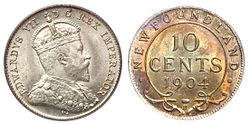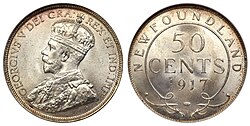Coins of the Newfoundland dollar
The coins of Newfoundland are of historical importance as Newfoundland was a British colony until 1907, and a Dominion until 1949, when Newfoundland and Labrador became the tenth province of Canada.
Traders' tokens

Rutherford brothers
The first Newfoundland traders' tokens were Halfpenny tokens issued by brothers Robert & I.S. Rutherford in St John's in 1840–41.[1] There are two varieties of the tokens - a dated type and an undated type.
In 1846, after a fire destroyed the St. John's store, two additional Rutherford Brothers (George and Andrew) opened a new store in Harbour Grace and issued a second set of tokens, inscribed RUTHERFORD BROS.[1] These pieces were minted by Ralph Heaton & Sons of Birmingham, England (commonly known as Heaton's Mint).[1] These pieces are unique in one respect - they have the 'RH' mintmark above the date.
The Peter M'Auslane farthing
Another early Newfoundland traders' token was issued in the 1840s by Peter M'Auslane, a general merchant in St John's.[2] Following the same 1846 St. John's fire which destroyed his business, he left Newfoundland and settled in Upper Canada (now Ontario).
The obverse of this very rare piece is inscribed 'PETER M'AUSLANE St. JOHNS NEWFOUNDLAND', and the reverse is inscribed 'SELLS ALL SORTS OF SHOP & STORE GOODS'.
Anonymous issues
These pieces do not bear either an issuer's name or a place name. There were two issues of these pieces: a Halfpenny dated 1858 and a Halfpenny dated 1860.[2]
The 1858 Halfpenny token, which is very rare, has a ship on the obverse similar to the Ship Halfpenny tokens from Prince Edward Island. The date 1858 alone appears across the centre of the reverse.
The 1860 Halfpenny token, which is scarce has the date 1860 in the centre of the obverse inside a circle. The inscription FISHERY RIGHTS FOR NEWFOUNDLAND is enclosed outside the inner circle. The reverse of this piece is inscribed RESPONSIBLE GOVERNMENT going around the outside and AND FREE TRADE is in the centre of the reverse. This piece makes a political statement on promoting the fishing industry and asserting a claim to responsible government.
Newfoundland dollar coinage (1865–1947)
In 1865, Newfoundland changed over to decimal currency following the footsteps of Canada, New Brunswick, and Nova Scotia. Pattern coins were issued in 1864, as were specimen cents.
Newfoundland was the only British North American colony to have its own gold coin (though the Ottawa mint also produced gold sovereigns). Originally, a gold dollar was considered, but it was decided it might be lost by the fishermen due to its small size. Thus, a two-dollar denomination was chosen for the gold coin.[3] Three (equivalent) denominations were indicated on the coin, as it was denominated as $2, 200 cents, and 100 pence (equivalent value in sterling).
Complete type set of Newfoundland dollar coinage
| Monarch | Value | Obverse/Reverse | Issue date[4][nb 1] | Design |
|---|---|---|---|---|
| Victoria | 
|
1865, 1872(H) 1873, 1876(H) 1880, 1885 1888, 1890 1894, 1896 |
Horace Morehen (des) Thomas Minton (eng)[7] | |

|
1865, 1870 1872(H), 1873[nb 2] 1876(H), 1880–81 1882(H), 1885 1888, 1890 1894, 1896 |
Leonard Charles Wyon[8] | ||

|
1865, 1870 1872(H), 1873 1876(H), 1880 1882(H), 1885 1888, 1890 1894, 1896 |
Leonard Charles Wyon[9][nb 3] | ||

|
1865, 1870 1872(H), 1873 1876(H), 1880–81 1882(H), 1885 1888, 1890 1894, 1896 1899, 1900 |
Leonard Charles Wyon[10] and Horace Morehen[11] | ||

|
1870, 1872(H) 1873–74, 1876(H) 1880–81, 1882(H) 1885, 1888 1894, 1896 1898–1900 |
Leonard Charles Wyon[12] | ||

|
1865, 1870 1872, 1880–81[nb 4] 1882(H), 1885 1888 |
Leonard Charles Wyon[14] | ||
| Edward VII | 
|
1904(H) 1907 1909 |
George William de Saulles (obv) Horace Morehen (rev)[15] | |

|
1903 1904(H) 1908 |
George William de Saulles[16] | ||

|
1903 1904(H) |
George William de Saulles[17] | ||

|
1904(H) | George William de Saulles (obv)[18] W.H.J. Blakemore(rev)[19] | ||

|
1904(H) 1907–09 |
George William de Saulles (obv)[20] W.H.J. Blakemore (rev)[21] | ||
| George V | 
|
1913 1917(C) 1919–20(C) 1929 1936 |
Edgar Bertram MacKennal (obv) Horace Morehen (rev)[22] | |

|
1912 1917(C) 1919(C) 1929 |
Edgar Bertram MacKennal (obv) George William de Saulles (rev)[23] | ||

|
1912 1917(C) 1919(C) |
Edgar Bertram MacKennal (obv) George William de Saulles (rev)[24] | ||

|
1912 | Edgar Bertram MacKennal (obv) W.H.J. Blakemore (rev)[19] | ||

|
1917(C) 1919(C) |
Edgar Bertram MacKennal (obv) W.H.J. Blakemore (rev)[25] | ||

|
1911 1917–19(C) |
Edgar Bertram MacKennal (obv) W.H.J. Blakemore (rev)[21] | ||
| George VI | 
|
1938, 1940 1941(C), 1942 1943–44(C) 1947(C) |
Percy Metcalfe (obv) Walter J. Newman (rev)[22] | |

|
1938, 1940–43(C) 1944–47(C)[nb 5] |
Percy Metcalfe (obv) George William de Saulles (rev)[26] | ||

|
1938, 1940 1941–44(C) 1945–47(C)[nb 6][nb 7] |
Percy Metcalfe (obv) George William de Saulles (rev)[27] |
References
Footnotes
- ^ The combination of Issue date and presence or absence of a mintmark confirms the place of issue. Canadian coins between 1858–1907 were struck in England either by the Royal Mint in London (no mintmark), or the Heaton Mint in Birmingham (mintmark letter H).[5] In 1908 the Royal Mint opened a branch in Ottawa and used the letter "C" as a mintmark.[6]
- ^ 1873 5-cent Newfoundland coins were struck both with and without the "H" mintmark.
- ^ The 1871H coins are rare and have Canada's reverse design. All 1880s have the second 8 punched over a 7.
- ^ The 1880 two-dollar gold coin is rare with a total mintage of 2,500 pieces.[13]
- ^ In 1944 and 1945 the 5-cent and 10-cent coins (respectively) depicting George VI were slightly altered in content but not design. The silver purity was reduced from 0.9259 to 0.8000 resulting in a silver weight change in both the 5-cent (0.0350oz to 0.0300oz)[26] and 10-cent (0.0701oz to 0.0600oz) coins.[24]
- ^ The 1946C 10-cent coin is rare with a total mintage of 2,041 pieces.[26]
- ^ In 1944 and 1945 the 5-cent and 10-cent coins (respectively) depicting George VI were slightly altered in content but not design. The silver purity was reduced from 0.9259 to 0.8000 resulting in a silver weight change in both the 5-cent (0.0350oz to 0.0300oz)[26] and 10-cent (0.0701oz to 0.0600oz) coins.[24]
Notes
- ^ a b c 19th Century Canada Genuine Trade Tokens, London Numismatic Club, retrieved 10 April 2015
- ^ a b Coins and Tokens, Historica Canada, retrieved 10 April 2015
- ^ W.K. Cross (2005). Canadian Coins (59 ed.). Charton Press. p. 55.
- ^ Cuhaj 2012, pp. 269–78.
- ^ Berman 2008, p. 137.
- ^ Cuhaj 2012, p. 15.
- ^ Coin - 1 Cent, Newfoundland, 1865, Museum Victoria, archived from the original on 11 April 2015, retrieved 5 April 2015
- ^ Coin – 5 cents, Newfoundland, 1880, Museum Victoria, archived from the original on 10 April 2015, retrieved 31 March 2015
- ^ Coin – 10 cents, Newfoundland, 1880, Museum Victoria, archived from the original on 10 April 2015, retrieved 31 March 2015
- ^ Coin – 20 cents, Newfoundland, 1965, Museum Victoria, archived from the original on 10 April 2015, retrieved 31 March 2015
- ^ 20 cents of Victoria, Newfoundland, Yale University Art Gallery, retrieved 10 April 2015
- ^ Coin – 50 cents, Newfoundland, 1882, Museum Victoria, archived from the original on 10 April 2015, retrieved 31 March 2015
- ^ Cuhaj 2012, p. 278.
- ^ Coin – 2 Dollars, Newfoundland, 1885, Museum Victoria, archived from the original on 10 April 2015, retrieved 31 March 2015
- ^ Cuhaj 2012, p. 269.
- ^ Coin - 5 Cents, Newfoundland, 1904, Museum Victoria, archived from the original on 11 April 2015, retrieved 5 April 2015
- ^ Coin - 10 Cents, Newfoundland, 1904, Museum Victoria, archived from the original on 11 April 2015, retrieved 5 April 2015
- ^ Coin - 20 Cents, Newfoundland, 1904, Museum Victoria, archived from the original on 11 April 2015, retrieved 5 April 2015
- ^ a b Cuhaj 2012, p. 275.
- ^ Coin - 50 Cents, Newfoundland, 1904, Museum Victoria, archived from the original on 11 April 2015, retrieved 5 April 2015
- ^ a b Cuhaj 2012, p. 277.
- ^ a b Cuhaj 2012, p. 270.
- ^ Cuhaj 2012, p. 271.
- ^ a b c Cuhaj 2012, p. 273.
- ^ Cuhaj 2012, p. 276.
- ^ a b c d Cuhaj 2012, p. 272.
- ^ Cuhaj 2012, p. 274.
Works cited
- Berman, Allen G. (2008). Warman's Coins And Paper Money: Identification and Price Guide (4 ed.). Krause Publications. ISBN 978-0-89689-683-3.
{{cite book}}: Invalid|ref=harv(help) - Cuhaj, George S., ed. (2012). Canadian Coin Digest (2 ed.). Krause. ISBN 978-1-4402-2985-5.
{{cite book}}: Invalid|ref=harv(help) - Coins of Canada by J.A. Haxby & R.C. Willey.
